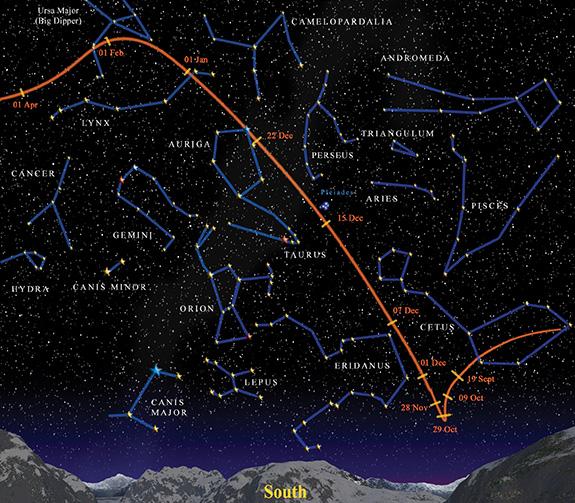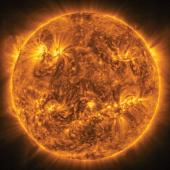Celestial Buckshot
Observing fall’s comets.
When beggars die there are no comets seen. The heavens themselves blaze forth the death of princes. —Shakespeare, Julius Caesar
In the old days—the really old days—people liked their sky regular and predictable. So when something unexpected appeared, it put people on edge. Thus it was that comets, those “hairy” stars that showed up briefly from time to time, acquired a bad reputation for portending death and destruction, especially for the elites. But the comets that will bracket the skies of autumn this year, flirting with naked-eye visibility, offer nothing more dire than catching a chill if you go out to look for them.
Comets are small icy leftovers from the formation of the solar system orbiting at the distant edge of the sun’s realm. A chance collision or a gravitational nudge from a passing star can send them inward to swing around the sun, where the sun’s heat vaporizes ice and carries away dust. It’s the reflecting dust and glowing gas that give the comet its hairy appearance, with a ballooning fuzzy “head” and drifting tail.
If they pass near planets—especially massive Jupiter—further gravitational nudges can fling them out of the solar system or capture them in short-period orbits. It is two captured or “periodic” comets that we have a chance to see this fall.
The first is Comet Giacobini-Zinner, the parent of the Draconid meteor shower that peaks around October 8 when we pass near the comet’s orbit and encounter bits of shed debris. It returns to the vicinity of the sun every 6.5 years, and passes nearest to the sun on September 10. It will be brightest in September on the verge of fall, shifting its position from night to night through Auriga and to the left of the bright star Betelgeuse in Orion in the pre-dawn sky.
Comets are notoriously unpredictable, but Giacobini-Zinner is forecast to perhaps just reach naked-eye visibility as a dim fuzzy blotch. If it doesn’t get that bright, it should still be visible through binoculars if you check the finding charts and know where to look. You may notice a short tail.
The second comet is expected to get brighter. It’s Comet Wirtanen, scheduled to arrive at the end of fall on its 5.4-year orbit. This comet reaches perihelion, its closest point to the sun, on December 12 and is closest to us on December 16—just 30 moon distances away—at which time it lies alongside the Pleiades star cluster in Taurus.
As it zips south-to-north to the west of Orion and through Taurus and Auriga from late November through December, it is predicted to get possibly as bright as third or fourth magnitude (the brightness of a medium-bright naked-eye star), showing an extended fuzzy head or “coma” and perhaps a stretch of tail. Even if it doesn’t get quite that bright, it should still be an easy find in your binoculars, nicely placed in the evening sky looking south.
Such unwelcome appearances in days long gone would surely have given kings and countries pause as they looked for something for which to blame them. Today, we take them in stride as relics of the earliest days of the solar system putting on a show in the night sky.
A fall camping or hunting trip or any other good excuse to be outdoors in the crisp autumn night will afford an opportunity to see these celestial interlopers. Take your binoculars and be sure to hunt for the comets in the sky!
Jim Manning, formerly the executive director of the Astronomical Society of the Pacific in San Francisco, lived outside Bozeman for many years and has returned to live here once again.












